.
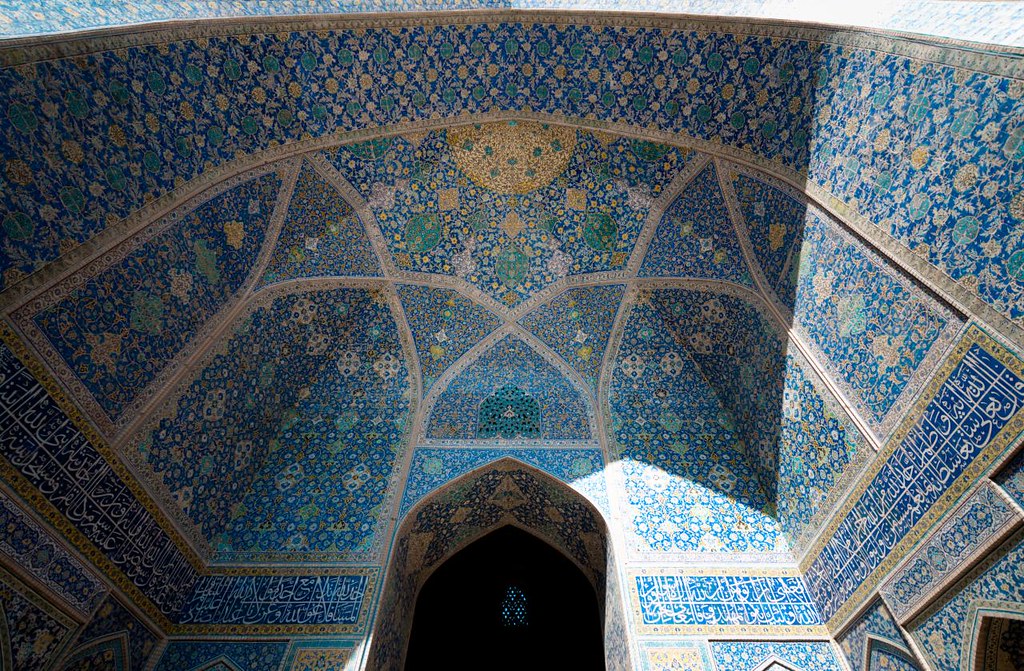
Imam (formerly Shah) Mosque (Masjed-e Imam), Isfahan: photo by Dara Mulhern, 18 October 2010
When I was a child
I thought a handgun in a holster
and the lead colored bullets on the belt
was one of the most beautiful things
made by man.
Of course at that time
I didn't consciously know
of the phallic significance or symbol,
but it doesn't really matter.
It's not the object now
but the feeling that accompanied,
which still remains and comes back,
but not for guns and bullets
but for eternity.
It must be the way Sumerians
felt for their Gilgamesh
and Jews for David
and Egyptians for Pharaoh
and anyone for heroes,
a hope of eternity
for ever and ever new.
A chance not for the object
but for the soul alone,
if that be possible.
But it's too easy
to love life too much
and all is gone away, alas,
like a shot from
the gun of childhood.
When I was a child
I thought of eternity.
Joseph Ceravolo (1934-1988): Hand Gun, 24 October 1986, from Collected Poems, 2012
Against the lucidity of instinct he opposed the instinct for lucidity: the invisible is not obscure or mysterious, it is transparent...
Octavio Paz on Marcel Duchamp, in Paz: Marcel Duchamp: Appearance Stripped Bare, translated by Rachel Phillips and Donald Gardner, 1978
The conventional view holds that girih (geometric star-and-polygon, or strapwork) patterns in medieval Islamic architecture were conceived by their designers as a network of zigzagging lines, where the lines were drafted directly with a straightedge and a compass. We show that by 1200 C.E. a conceptual breakthrough occurred in which girih patterns were reconceived as tessellations of a special set of equilateral polygons ("girih tiles") decorated with lines. These tiles enabled the creation of increasingly complex periodic girih patterns, and by the 15th century, the tessellation approach was combined with self-similar transformations to construct nearly perfect quasi-crystalline Penrose patterns, five centuries before their discovery in the West.
Decagonal and Quasi-Crystalline Tilings in Medieval Islamic Architecture, by Peter J. Lu and Paul J. Steinhardt: abstract of a paper in Science 23, February 2007, Vol. 315. no. 5815
For all their tantalizing glimpses into medieval scientific knowledge, the designs of the Darb-i Imam [in Isfahan, taken by Peter Lu as a template for his thesis] and other Islamic buildings must also be understood in their religious context. Geometric patterns in Islamic architecture and ornamentation were used as much for spiritual as for artistic reasons. As Robert Irwin writes in his study of Islamic art, such patterns may have been viewed 'as exteriorized representations of abstract, even mystical, thought' -- aiming to inspire contemplation or to make a statement about the imponderable harmonies of a divinely ordered universe. Sufism in particular is closely linked to the practice of geometry, above all in the form of symmetries, as a way of giving physical expression to mystical thought.
The girih designs are thus comparable to Gothic art and architecture in another sense, namely in their shared ambition to embody spiritual cogitation and emotion through geometry. The real significance of the magnificent tiling of the Darb-i Imam lies not in any kind of cultural one-upmanship about who first conceived a certain idea or technique, but rather in the remarkable trajectories of ideas and scientific endeavors through time.
Sebastian R. Prange, on the Lu thesis, in Islamic Arts and Architecture, 20 May 2012
I thought a handgun in a holster
and the lead colored bullets on the belt
was one of the most beautiful things
made by man.
Of course at that time
I didn't consciously know
of the phallic significance or symbol,
but it doesn't really matter.
It's not the object now
but the feeling that accompanied,
which still remains and comes back,
but not for guns and bullets
but for eternity.
It must be the way Sumerians
felt for their Gilgamesh
and Jews for David
and Egyptians for Pharaoh
and anyone for heroes,
a hope of eternity
for ever and ever new.
A chance not for the object
but for the soul alone,
if that be possible.
But it's too easy
to love life too much
and all is gone away, alas,
like a shot from
the gun of childhood.
When I was a child
I thought of eternity.
Joseph Ceravolo (1934-1988): Hand Gun, 24 October 1986, from Collected Poems, 2012
Against the lucidity of instinct he opposed the instinct for lucidity: the invisible is not obscure or mysterious, it is transparent...
Octavio Paz on Marcel Duchamp, in Paz: Marcel Duchamp: Appearance Stripped Bare, translated by Rachel Phillips and Donald Gardner, 1978
The conventional view holds that girih (geometric star-and-polygon, or strapwork) patterns in medieval Islamic architecture were conceived by their designers as a network of zigzagging lines, where the lines were drafted directly with a straightedge and a compass. We show that by 1200 C.E. a conceptual breakthrough occurred in which girih patterns were reconceived as tessellations of a special set of equilateral polygons ("girih tiles") decorated with lines. These tiles enabled the creation of increasingly complex periodic girih patterns, and by the 15th century, the tessellation approach was combined with self-similar transformations to construct nearly perfect quasi-crystalline Penrose patterns, five centuries before their discovery in the West.
Decagonal and Quasi-Crystalline Tilings in Medieval Islamic Architecture, by Peter J. Lu and Paul J. Steinhardt: abstract of a paper in Science 23, February 2007, Vol. 315. no. 5815
For all their tantalizing glimpses into medieval scientific knowledge, the designs of the Darb-i Imam [in Isfahan, taken by Peter Lu as a template for his thesis] and other Islamic buildings must also be understood in their religious context. Geometric patterns in Islamic architecture and ornamentation were used as much for spiritual as for artistic reasons. As Robert Irwin writes in his study of Islamic art, such patterns may have been viewed 'as exteriorized representations of abstract, even mystical, thought' -- aiming to inspire contemplation or to make a statement about the imponderable harmonies of a divinely ordered universe. Sufism in particular is closely linked to the practice of geometry, above all in the form of symmetries, as a way of giving physical expression to mystical thought.
The girih designs are thus comparable to Gothic art and architecture in another sense, namely in their shared ambition to embody spiritual cogitation and emotion through geometry. The real significance of the magnificent tiling of the Darb-i Imam lies not in any kind of cultural one-upmanship about who first conceived a certain idea or technique, but rather in the remarkable trajectories of ideas and scientific endeavors through time.
Sebastian R. Prange, on the Lu thesis, in Islamic Arts and Architecture, 20 May 2012

Main Dome, Imam (formerly Shah) Mosque (Masjed-e Imam), Isfahan (1611-1629}: photo by Dara Mulhern, 18 October 2010

Side Dome, Imam (formerly Shah) Mosque (Masjed-e Imam), Isfahan: photo by Dara Mulhern, 18 October 2010
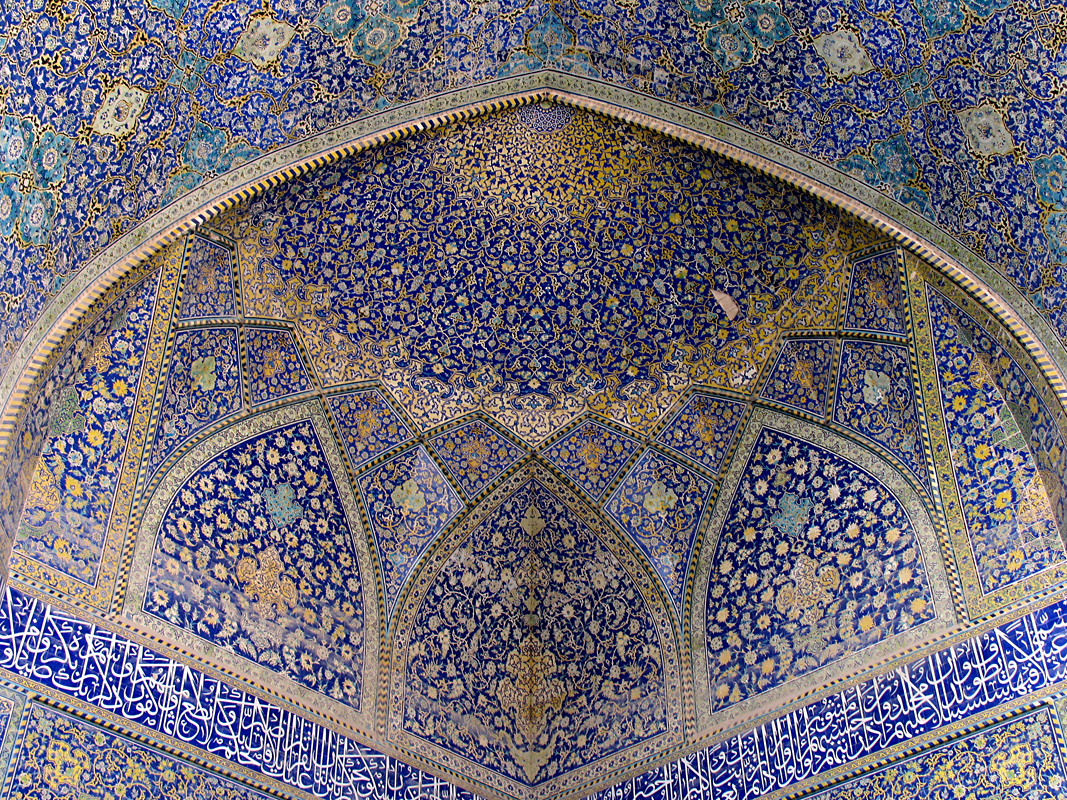
Imam (formerly Shah) Mosque, Isfahan: photo by HORIZON, 18 May 2006
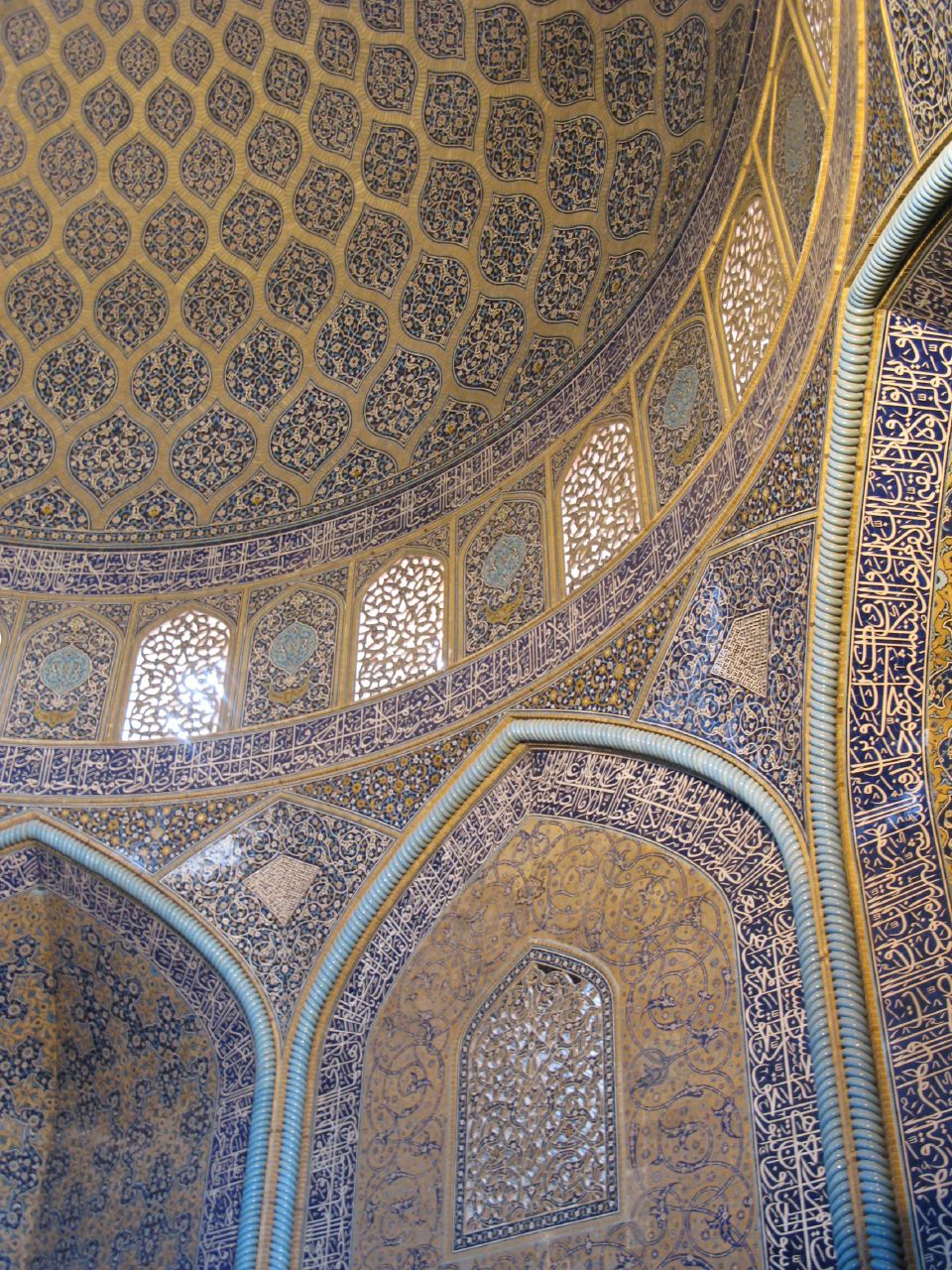
Sheikh Lotf Allah Mosque, Isfahan: photo by oceanbaby, 4 May 2007
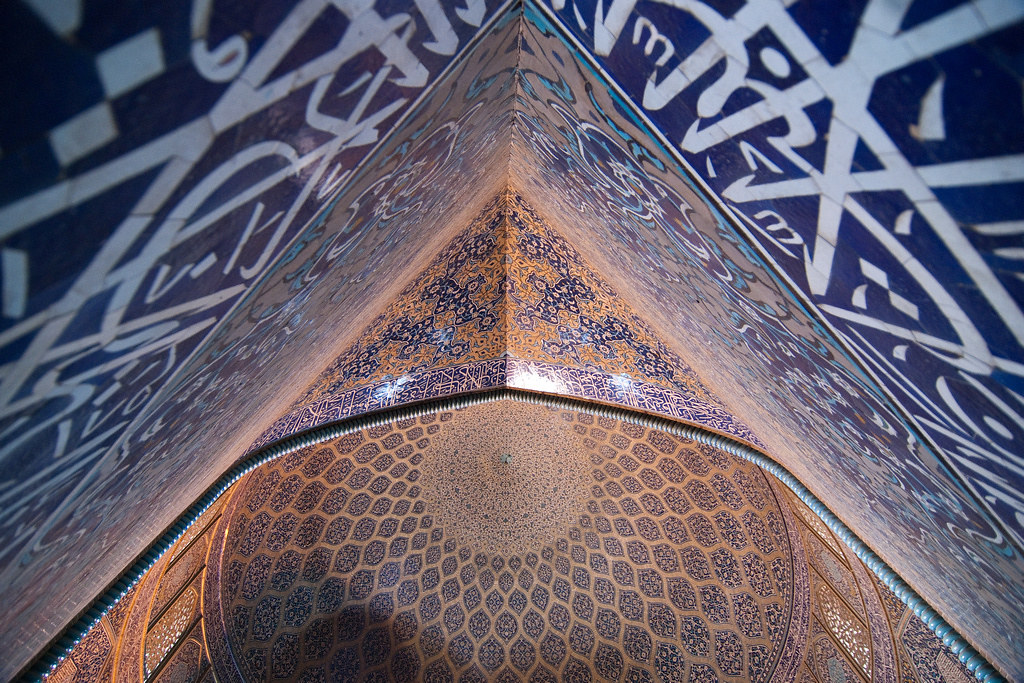
Sheikh Lotf Allah Mosque, Isfahan: photo by Behrooz Bashokooh, 15 March 2011

Muqarnas, Sheikh Lotf Allah Mosque, Isfahan: photo by Mandana Fard (baraneh), 8 January 2008

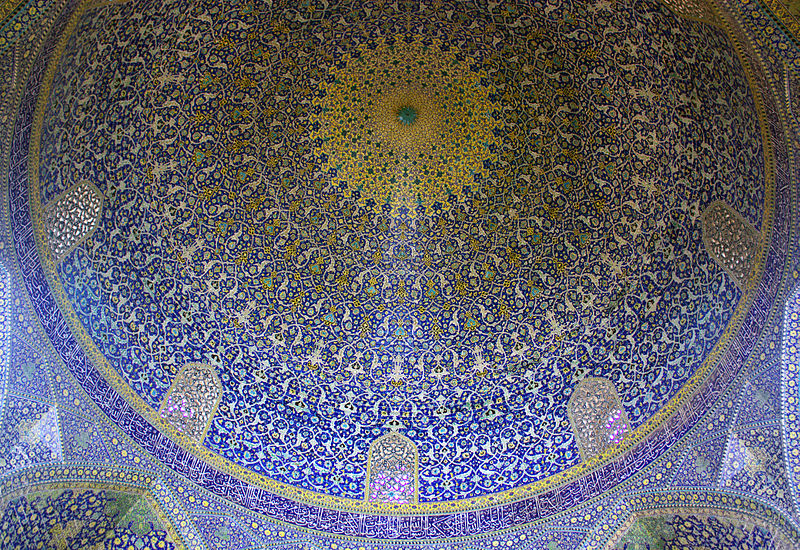
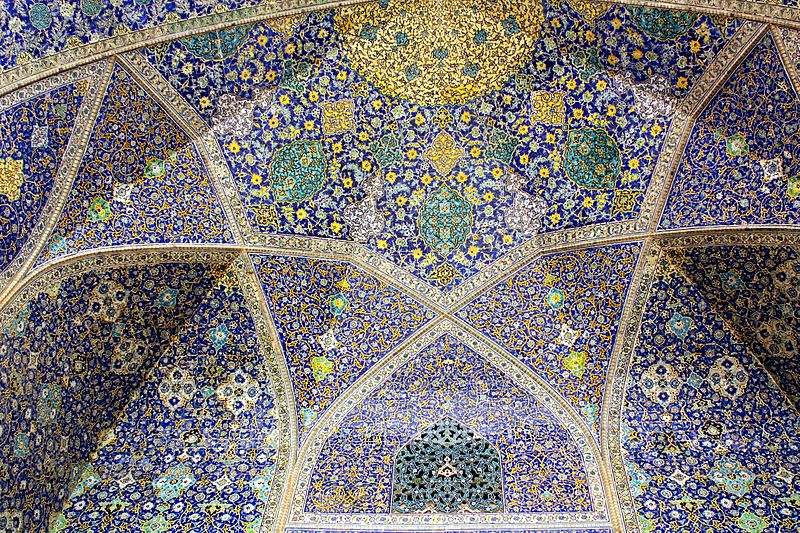


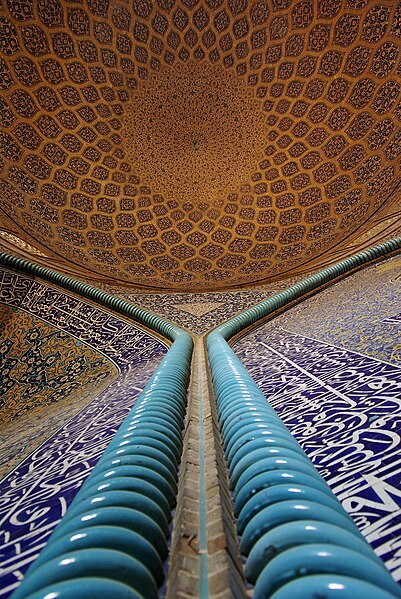




9 comments:
How had I never heard of Ceravolo until this year? Is there a particular volume I should start with to catch the bug?
Tom – good (for me) to see a new post from you, to selfishly know you are there, in time, pondering eternity.
When I was a child, perhaps like you, I drew the baseball players, their motions, fields, bats, gloves, the ball itself. I spent hours in my room drawing. What was outside was too horrifying. I stayed in the room attempting to evoke depth from the plane of the paper.
The ballfields and the players still soothe me. I especially love the geometry of the stadium, the arc of the throw, the sailing sphere.
I also, like Joe, loved the guns, holsters, cartridge belts, bullets. I drew them too. Also jets, tanks, bazookas, machine guns and soldier-players. I was an American post-war artist boy. The war machines, even footage of nuclear test clouds still fill me with awe, an awful kind of beauty.
These Islamic designs are from a time when the scimitar, a curved weapon was the one of the lethal choices of warriors. “The kilij is a scimitar used by the Turks and the Ottoman Empire; it appeared around the 15th century. The kilij is a unique kind of scimitar that has a slight taper down the straight of the blade until the last third of the sword, when it angles sharply and becomes deeper. After the First Barbary War, a bejeweled kilij was presented to the commanding Marine officer, thus beginning the tradition of granting, to all United States Marine Corps officers, the right to carry the ceremonial weapon as part of that tradition.” (Wikipedia – under scimitar)
Now I have boxed myself into a tiny corner of time (a subset of eternity?) where the Four Horsemen gather, connected to this computer machine. Earlier, it informed me that Monsanto may or may not have a working relationship with Blackwater.
I was glad then to discover your “'exteriorized representations of abstract, even mystical, thought'.” I am grateful for this work you do.
Outside the dome of the sky works its morning magic. Last night the sunset was exquisite and disorderly.
When I was a child I never thought of eternity. I saw beauty. Beauty sustained me when I left the drawing board. Later, pain and wonderment made eternity more apparent. Here, in time, one hopes to be heroic. That would be ideal. That would approach the boundlessness of eternity.
Harris
Tom,
"the invisible is not obscure or mysterious, it is transparent..."
7.28
light coming into fog against invisible
ridge, drop falling from leaf on branch
in foreground, sound of wave in channel
coordinate, with respect to
rotations of it seems
from in first place, second
term, more after some
fog against invisible shoulder of ridge,
fog on horizon to the left of the point
Ceravolo never gives way to cheap allegories, always starts with the things themselves and lets them communicate. The most spiritually aware and sensuous of poets.
"Later, pain and wonderment made eternity more apparent".
Thank you, Harris. That eternity might be felt (not virtual or hypertextual), there's such hope in this.
WOW! I had not heard of Cervalo either.
Ceravolo forever.
"Ceravolo forever" -- hear, hear!
"...always starts with the things themselves and lets them communicate. The most spiritually aware and sensuous of poets."
As for catching up, a few steps:
Joseph Ceravolo: Beginner Method
Joseph Ceravolo: Cat of Eternity
Joseph Ceravolo: Dusk
Joseph Ceravolo: Lighthouse
Joseph Ceravolo: May
Harris, beautiful that the intense secret faiths of lonesome childish private creation be recalled.
Joe's poems wonderfully always kept that child's own-world quality, a naïvete that has grown up yet doesn't know about faux, has somehow not lost the original direct unmediated experiencing of the world (and words) as realities existing prior to all irony or attitude.
I had that same early sketchpad and crayon subject matter, yes. The green enchanted diamond. Along with the weaponry and explosions, 1940s wartime heroic subject matter evoked by night fears of phantom invasions in the dark, across unseen oceans, dive bombers plunging down black air shafts & c... Kids never knew what was going on back then, knowledge (such as it was) consisted of the warped gleanings gathered from listening behind doors or down dark tenement hallways. A lot of that imagery came back (unexpected, unwanted) after 9/11... still confused, as in the beginning.
Silhouettes in the Shade
Hey Tom, I wonder if the Yanks will win tomorrow? I wonder if Derek will hit another home run? I wonder if PRISM got every word? My son saw a tee shirt that said “USA, Back to Back World War Champions.” I’ll try to write a poem like Joe Ceravolo might have written. I wonder if Eternity sparkles.
Love,
Harris
Eternity sparkles like Derek's bald spot glimmering in the Eternal Sunshine of New York's Spotless Mind.
The celestial clockmaker knew what was going on up there in the Big Mondo Sky Dome when the pure abstraction of Derek's stats was invented.
Take that magic number, 3000... was it hits or girlfriends, again?
Post a Comment